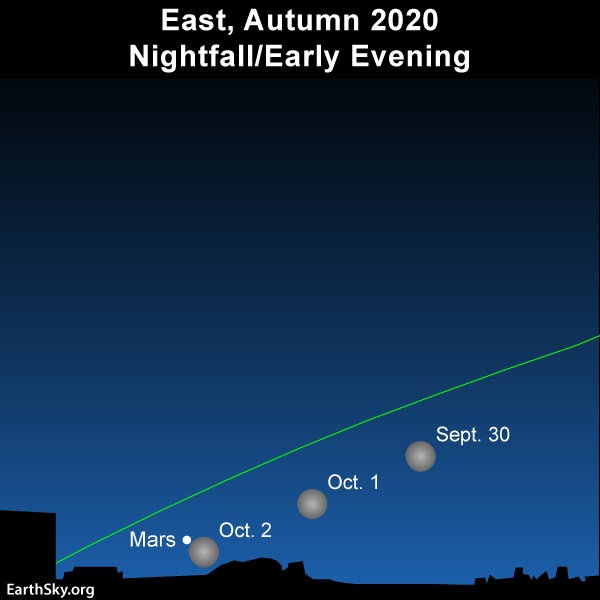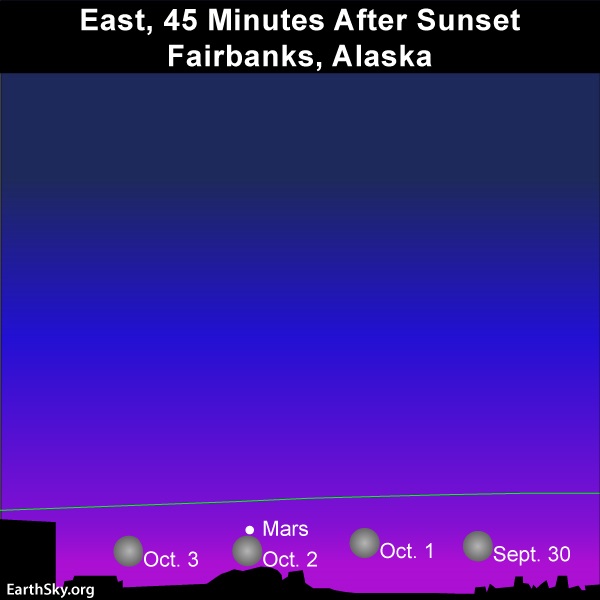
Depending on where you live worldwide, the upcoming full moon will fall on October 1 or 2, 2020. For the Northern Hemisphere, this full moon counts as our Harvest Moon (full moon nearest the September equinox) and the first full moon of the autumn season. For the Southern Hemisphere, it’s the first full moon of spring. No matter where you live, look for a full-looking moon to light up the nighttime from dusk until dawn these next few nights. What’s more, that nearby brilliant red “star” to the east of the moon is no star at all. It’s the red planet Mars, now poised to reach its once-in-two-years opposition in our sky.
Mars will come to opposition – when Earth will swing between the sun and Mars – on October 13, 2020. At that time, the red planet will be rising in the east as the sun is setting in the west. Around now – just two weeks shy of opposition – Mars is rising near the time of sunset. It’s dazzlingly bright (brighter than all the stars, and even brighter than Jupiter), and it’s fiery red in color. You can’t miss Mars as the bright, red, starlike object ascending in the east each evening. Mars will be brighter at this year’s opposition than it will be again until the year 2035. Read more about Mars and its 2020 opposition.
And now … about that Harvest Moon in early October. In 2020, it’s a precursor to a Blue Moon on October 31. That’s because – when there are two full moons in a single calendar month – many people call the second one a Blue Moon. Read more: When is the next Blue Moon?
(If you live in the far-eastern part of the globe – eastern Australia, New Zealand – the second and third full moons of the spring season actually comes in early and late November 2020, meaning the second full moon of November 2020 counts as your Blue Moon.)
Astronomers define a season as the time period between an equinox and a solstice, or vice versa. Typically, there are three full moons in one season. In 2020, the season between the September 2020 equinox and the December 2020 solstice harbors the typical three full moons.
September 2020 equinox: September 22 at 13:31 UTC
Full moon: October 1 at 21:05 UTC (Harvest Moon)
Full moon: October 31 at 14:49 UTC (monthly Blue Moon)
Full moon: November 30 at 09:30 UTC
December 2020 solstice: December 21 at 10:02 UTC
Next year, in 2021, the full moons will come about 11 calendar days earlier than in 2020. Therefore, it should come as no surprise that next year’s sole September full moon will fall on September 20, 2021 (11 days previous to October 1). This will also be the Northern Hemisphere’s full Harvest Moon, but the last full moon of the summer season (instead of the first full moon of autumn). Moreover, four full moons (instead of the typical three full moons) will fall between the June 2021 solstice and the September 2021 equinox.
June 2021 solstice: June 21 at 03:32 UTC
Full moon: June 24 at 18:40 UTC
Full moon: July 24 at 2:37 UTC
Full moon: August 22 at 12:02 UTC (seasonal Blue Moon)
Full moon: September 20 at 23:55 UTC (Harvest Moon)
September 2021 equinox: September 22 at 19:21 UTC
It is somewhat rare to have four full moons in one season, so some people call the the third of a season’s four full moons a Blue Moon. Almanac makers chose to call third full moon (instead of the fourth full moon) of the season a Blue Moon, so that full moon nomenclature would match up with the season’s other three full moons.
Typically, a calendar year harboring a monthly Blue Moon (second of two full moons in one month) precedes a calendar year with a seasonal Blue Moon (third of four full moons in one season). Looking ahead to the year 2023, the monthly Blue Moon on August 31, 2023, will be followed by the seasonal full moon on August 19, 2024; and looking ahead to the year 2026, the monthly Blue Moon on May 31, 2026, will be followed by a seasonal Blue Moon on May 20, 2027.
In the meantime, the Northern Hemisphere’s Harvest Moon is always the full moon falling the closest to the autumnal equinox, whether it be the last full moon of summer or the first full moon of autumn. This year’s Harvest Moon turns exactly full on October 1, 2020, at 21:05 UTC. Although the moon turns full at the same instant worldwide, the clock time of the full moon varies by time zone. At Northern American and U.S. times zones, that places the full moon instant during our daytime hours (when the moon is still below our horizon) on October 1 at 6:05 p.m. ADT, 5:05 p.m. EDT, 4:05 p.m. CDT, 3:05 p.m. MDT, 2:05 p.m. PDT, 1:05 p.m. Alaskan Time and 11:05 a.m. Hawaiian Time.

Any full Harvest Moon tends to rise in the east around sunset and to set in the west around sunrise. On the nights following the Northern Hemisphere’s full Harvest Moon, the waning gibbous moon rises farther and farther north along the eastern horizon each day for about a week. For the Northern Hemisphere, these more northerly moonrises reduce the lag time between successive moonrises to yearly minimum (and in the Southern Hemisphere, these more northerly moonrises increase the lag time to a yearly maximum).

Whereas the effect is minimal in the tropics, the Harvest Moon phenomenon is more profound at high latitudes. On the average, the moon rises some 50 minutes later daily. But at 40 degrees north latitude, the moon presently rises some 25 minutes (instead of 50 minutes) later daily. At and around 60 degrees north latitude, moonrise comes at or nearly the same time for about a week.
Denver, Colorado (40 degrees north latitude)
Moonrise September 30: 6:40 p.m. MDT (Mountain Daylight Time)
Moonrise October 1: 7:03 p.m. MDT
Moonrise October 2: 7:27 p.m. MDT
Moonrise October 3: 7:51 p.m. MDT
Source: Old Farmer’s Almanac
The Harvest Moon phenomenon happens because the ecliptic – approximate monthly pathway of the moon – intersects the horizon at its shallowest angle of the year at sunset on the autumn equinox. At the equator and the tropical regions of the world, however, the ecliptic always intersects the horizon at a steep angle, so the Harvest Moon effect there is negligible. But at and near the Arctic Circle, the ecliptic pretty much parallels the horizon at sundown at this time of year, meaning the moon rises close to the same time for days on end. At far-northerly latitudes, it’s even possible for the moon to rise earlier day by day. Check out Fairbanks, Alaska, below!
Fairbanks, Alaska (65 degrees north latitude)
Moonrise September 30: 7:57 p.m. AKDT (Alaska Daylight Time)
Moonrise October 1: 7:54 p.m. AKDT
Moonrise October 2: 7:51 p.m. AKDT
Moonrise October 3: 7:49 p.m. AKDT
Source: Old Farmer’s Almanac
Want to know the sunset/moonrise times for your part of the world? Click here to find a sky almanac.

In the days before electricity, farmers at northerly latitudes counted on the lamp of the Harvest Moon to gather their crops. Making up for the autumn season’s waning daylight, the Harvest Moon faithfully provides several nights of dusk-till-dawn moonlight. This bonanza of moonlit nights remains the legacy of the Harvest Moon!
Read more: All you need to know: 2020’s Harvest Moon
Bottom line: The full Harvest Moon will appear near bright red Mars on October 1-2, 2020.











